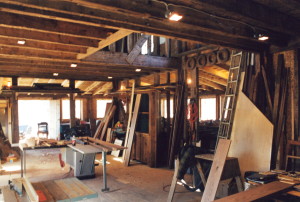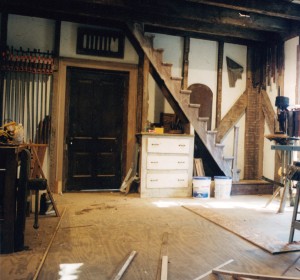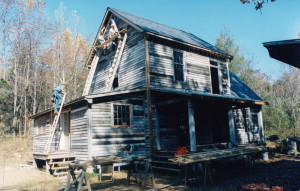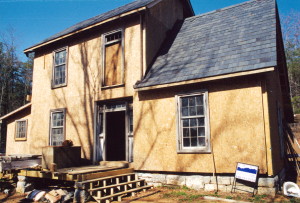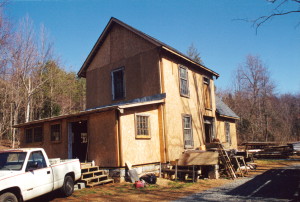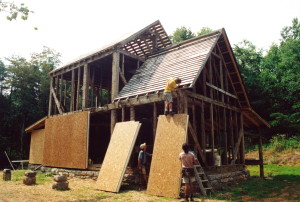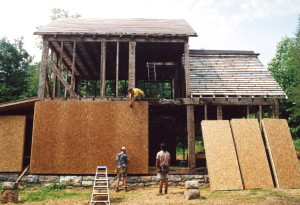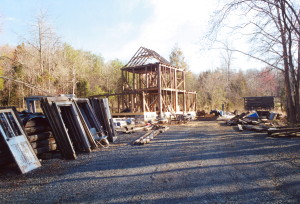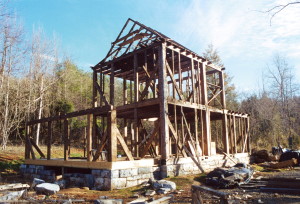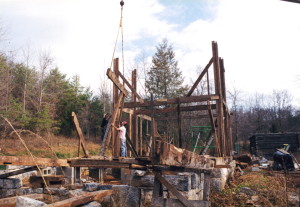Wood working shop… part 13
Noah Bradley2019-06-29T10:37:32+00:00We made use of the old attic stairway for use to get to the second floor of the shop.
Barely two feet wide and steeply pitched this original piece to the house took very little square footage out of the shop and since it was seldom used it fit our needs perfectly.
Originally posted 2015-06-06 09:13:06.
Wood working shop… part 12
Noah Bradley2019-06-29T10:37:31+00:00We don’t often save and reuse old siding, but here it worked.
Most of the time the siding on an old house is worn out, dry and brittle from years exposed to the weather. We have found that so much of it breaks apart that there is never enough quality material to reuse.
And besides, most clients want a crisp new finish to their homes… not the “Beverly Hillbillies” look. But, here, on this woodworking shop, we went for it.
Originally posted 2015-06-06 09:04:30.
Wood working shop… part 10
Noah Bradley2019-06-29T10:37:29+00:00Stress skin panels are light enough that these three men were able to cover this entire home by themselves without the aid of a crane.
And yet they were strong enough for this crew member to scamper up one of them with a handsaw to cut flush a peg that was still sticking out a bit.
Originally posted 2015-06-05 17:17:02.
Wood working shop… part 9
Noah Bradley2019-06-29T10:37:28+00:00Once the frame was complete we next covered the exterior with stress skin panels. I had these made differently than the standard type… these panels had wafer boards on both sides of the the foam core. I was not interested in having a nice painted drywall surface inside but rather wanted a wall surface where I could easily attach tools and cabinets.
Originally posted 2015-06-05 17:11:45.
Wood working shop… part 8
Noah Bradley2019-06-29T10:37:27+00:00The new shop begins to make her presence known in the center of my work lot. This is the area that for years I would store materials and pre-assemble log cabins.
Notice the old window units leaning against a stack of vintage logs in the foreground, ready to be reinstalled into the frame.
Originally posted 2015-06-05 15:14:27.
Wood working shop… part 7
Noah Bradley2019-06-29T10:37:26+00:00The timber frame began to take shape.
Notice again the wide hog-trough corners and angle bracing going down to the floor. I’ve yet to find a timber frame book that illustrates this method of vintage framing commonly found here in Virginia.
I reconfigured the old frame, bringing part of the second floor down to create more of a first floor and less of a second floor. A wood working shop has little need of an upper level. And should this shop ever be finished off into a finished home the new owners would also appreciate more first floor square footage.
Originally posted 2015-06-05 14:20:30.
Wood working shop… part 3
Noah Bradley2019-06-29T10:37:22+00:00There is no finer roofing material to have on a house than slate that is mined out of Buckingham Virginia.
Period.
It is beautiful to look at and it lasts forever. And a roof that lasts forever, (longer even than copper), will one day eventually work out to have been the lowest cost roofing choice.
Actually, they say Buckingham slate has a life expectancy of 175 years, but I am here to say that I have salvaged it off of houses that old and the slate on those structures still rings true… just like a bell when you hit it with your knuckles.
This house had an addition off one of it’s sides. There was no salvageable materials within this 20th century section… but we did harvest it’s slate… by using these pieces, as replacements for missing and damaged slates on the main section of the house, we now had enough material to put a slate roof on the future wood-working shop.
Originally posted 2015-06-04 14:38:27.

